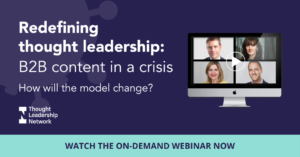Crisis marketing: Five traits that will change the way brands communicate through a global emergency
Rob Mitchell
There’s an old adage in marketing that you should always invest through a downturn. Over the years, research has shown that companies that stay visible during tough economic times and invest in crisis marketing will rebound more quickly when the cycle turns. While cuts to marketing budgets may make sense in the short-term, they rarely help in the long run. Shrinking away, even for a brief time, risks an erosion of brand loyalty and provides opportunities for competitors to gain share of voice.
While this may be generally understood by most savvy B2B marketers, there are important nuances all marketers must look to understand when it comes to publishing content in the crisis. During previous downturns, brands could more or less continue with their existing pre-crisis content strategy. Sure, you had to adjust your messaging slightly and apply extra scrutiny to the investment, but these were typically minor modifications rather than wholesale changes.
This time around, it feels different. B2B content marketers are having to shift radically their messaging, and constantly update it as the crisis develops. And, to some extent, they are flying blind. One big challenge is that their established mental map of the audience has become abruptly outdated. Customer preferences and priorities that once seemed permanent have altered drastically in a matter of weeks. And worse still, they are likely to change repeatedly in the coming months as the situation evolves.
So how should B2B content marketers react to the current crisis? In my view, there are five traits brand marketers need to demonstrate in order to keep their content visible, relevant and distinctive.
1. Show humility
It’s okay to acknowledge you don’t have all the answers, because no one does. Keep in mind that there are two main strands to effective thought leadership and crisis marketing: authority and empathy. Now more than ever it’s important to convey both.
Be authoritative when you are confident in what you have to say and can provide tangible solutions to problems. But when you can’t, use empathy to build a connection and emphasise the need for a collaborative approach to work through the most intractable challenges.
2. Be generous
Customers will remember those who helped them — and society at large — during the crisis. Be generous with your advice. This will build trust and reinforce a long-term emotional connection with your brand.
At a time when audiences need insight more than ever to help navigate such uncertainty, this is a chance to use crisis marketing to build a strong, lasting connection with them. Turn a negative into a positive and use this opportunity to generate a positive impact on your brand.
3. Embrace agile
This crisis is unlikely to progress in a linear way. There may be false starts and setbacks, with different markets and sectors emerging at different times and speeds. Your messaging needs to be tuned into this fast-changing context. That requires genuine agility – being able to turn on a dime and shift your perspective to meet the current needs of your audience.
Content needs to be developed quickly, which will mean waiving time-consuming stakeholder reviews and committee-like decision-making. A clear chain of command is required, as well as small, nimble teams that can flex their approach in a matter of hours, not weeks. But most importantly, test your content continually so that you learn what works and what doesn’t. Then, optimise your content production in real time.
4. Be observant
Be in no doubt, you audience’s priorities and needs have been transformed in a matter of weeks. While we are all living through the same experience, it’s highly likely that you no longer understand them as well as you did.
So it’s important for marketers to question every assumption they have about their buyer and to recalibrate where necessary. Listen to your audience and adopt a truly outside-in approach. Gather feedback from conversations with customers and feed this into your content strategy on an ongoing basis.
5. Develop ambidexterity
The trajectory of this crisis remains highly uncertain. This means that brands need to prepare for different scenarios and potential outcomes. Marketers need to develop content and points of view that are attuned to different phases of the crisis and be ready to publish or postpone them depending on how the emergency evolves.
A portfolio approach to your crisis marketing is key to ensuring that your messaging remains relevant. Focus on the short-term and medium-term content initiatives simultaneously. Allocate some of your resources to immediate, pragmatic advice on how to weather the current stage of the crisis, but also be prepared for the recovery. This means also focusing effort on a medium-term strategy with insight into how companies should start to emerge from the hardship. Be pragmatic and willing to reallocate resources from one to the other, depending on how the situation evolves.
Download our ebook for more specialist insight on how to communicate now and in the aftermath of Covid-19
 Over recent weeks, the business world as we know it has changed dramatically. Brands face the fight to remain relevant and leadership teams are being tested like never before. How will you need to change the way you produce thought leadership to remain distinctive and relevant?
Over recent weeks, the business world as we know it has changed dramatically. Brands face the fight to remain relevant and leadership teams are being tested like never before. How will you need to change the way you produce thought leadership to remain distinctive and relevant?
Find out by watching our on-demand webinar with experts from FT Longitude, Accenture, Mercer and Thought Leadership Network.
Speak to the team
We’ll help you to navigate and overcome any challenges you currently face and learn how to get more out of your content.
Book a meeting
About the author: Rob Mitchell
Rob is our CEO and co-founder and leads FT Longitude’s strategic planning and sets the overall vision and priorities for the business. He manages the board-level relationship with FT Longitude’s parent company, the Financial Times group, and also oversees FT Longitude’s finances, people management and administration.
Prior to co-founding FT Longitude in 2011, Rob was an independent writer and editor. Between 2007 and 2010, he was a managing editor at the Economist Intelligence Unit and prior to that he was an editor at the Financial Times, where he was responsible for the newspaper’s sponsored reports, including the Mastering Management series.
 |
Tel:
+44 (0)20 7873 4770
|
Tel:
+44 (0)20 7873 4770


